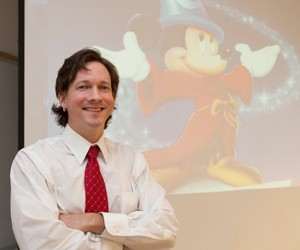
Roots of Consumerism May Lie in Disney Cartoons
Did Mickey Mouse's magic transform America into a consumerist society?
University of Cincinnati scholar Eric Jenkins has explored the connections between our consumerist impulses and the animation classics of Walt Disney. He will present one aspect of this study May 18 at the Athens International Educational Research Conference in Greece. His paper is titled "Of Mice and Mimesis: Disney and the Commodity Fetish."
While it is widely accepted that we live in a consumerist society (during a recent credit binge the average American household spent more than it earned), Jenkins said there has been little analysis about the role of media in the evolution of consumerism. Most of the available analysis has focused on the content of the animated films not on their formal and technical features.
What Im suggesting is that the type of animation perfected by Disney over his golden age from 1937 to 1955 not only promotes consumerist behavior, but trains us in the habits of consumerism, he said.
Over that period, with the release of full-length animated features like Snow White and Fantasia, Disney defined the grammar and style of animation. Jenkins, assistant professor of communication in UCs McMicken College of Arts & Sciences, sees a connection between how viewers absorb Disneys animation and how they relate to consumer products.
That influence, he said, is rooted in a media environment in which different media may have very different effects regardless of content. Cinema and animation, for example, appear to have much in common. Live-action cinema records moments in time, but animation compels the viewer to create the illusion of action over time from static drawings. Live-action cinema starts with reality, but animation can only mimic reality.
Whereas the viewer might think that they experience the real Will Smith in one of his roles, the idea that they see the real Mickey Mouse is nonsensical, Jenkins said.
It is this unreality, he said, that allows the viewer to invest more emotion into the experience of animation.
The viewer must fill in so much of the detail that they feel they are participating in the image-world, Jenkins said.
The person experiencing animation is experiencing something much like a childhood daydream in which inanimate objects become alive, have feelings and personalities.
It is not only that Disney endows certain objects within the screen with a magical aura, Jenkins said. Disney also conveys the idea that all of the objects on the screen are magical.
Disneys animators invested their creations with a particular type of magic, he said, that makes a fetish of objects. Viewers know that the animated images they are seeing are not real but respond emotionally as if they are.
In this environment, viewers look to inanimate objects, not as commodities, but as magical objects providing access to the pleasures experienced through animation. Jenkins calls this viewpoint materialized idealism or a collective dream of the perfectibility of our images.
It is, he said, a state of mind ripe for commercial exploitation.
Corporations have seized on this desire for emotional transfer and run with it, often to the detriment of democracy, labor, and the environment, Jenkins said.
The paper is part of a larger work on animation and consumerism that Jenkins is preparing for publication as a book.
Related Stories
Information Security Roadshow spreads awareness
May 3, 2024
The University of Cincinnati's Office of Information Security launched a series of 18 in-person sessions from January to April 2024, drawing nearly 350 attendees from the staff of various UC colleges and units. The Information Security Roadshow series aimed to equip the audience with knowledge on prevailing cyber threats, prevention strategies, how to report incidents and resources to stay informed and secure.
UC alum makes her mark in research, service
May 3, 2024
In 1960, as a young and eager statistician, Joan Reisch graduated from UC’s College of Arts and Sciences, and pursued a career in Texas at the Southwestern Medical Center where she’s held numerous roles as both faculty and staff. This year, Reisch was recognized for her career accomplishments and contributions with the Philanthropist of the Year Award by UC’s Alumni Association. This award is given to an alumnus who has been highly engaged in philanthropic activities with A&S, or has made a significant impact on the college.
UC launches new study of 'forever chemicals' in drinking water
May 2, 2024
The University of Cincinnati is launching a new investigation at its groundwater observatory to examine the ways toxins from distant sources get into drinking water.
